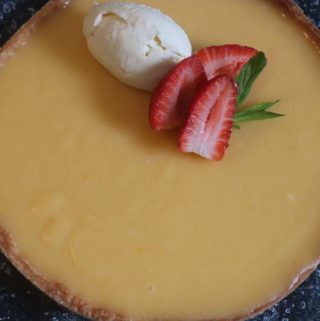
Lemon Tart made with delicious lemon curd
Deliciously deep in lemon flavour this tart contains no cream and doesnt need to be cooked once the lemon is poured into the case. Measurments are in Australian cup sizes
Ingredients
Pastry
- 240 gm flour, plain or 8.45 oz | 11/2 cups + 2 Tbsp
- 95 gm icing sugar, pure or 3.35 oz | 3/4 cup
- 120 gm butter, unsalted or 8.45 oz
- 50 gm egg, whole or Large egg size | 2.45 oz
- 5 ml cold water or 1 teaspoon
- 3 ml vanilla 1/2 teaspoon
Lemon Curd
- 150 ml lemon juice or approx 3 | 5.05 fl oz
- 150 gm egg or approx 3-4 eggs / 5.30 oz
- 120 gm caster sugar or 4.25 oz | 1/2 cup plus 1 Tbsp
- 75 gm butter or 2.65 oz
- 1.5 ea leaf gelatine or 1 teaspoon powdered gelatine
Instructions
Sweet Pastry
- You will need a tart tin. The tin should be approx 3 cm deep (1.20 inches) and can be anything from 20 cm to 26 cm ( 7.5 in 10 in). Straight sided or fluted. If you have a deeper tart tin you will need to double the lemon curd recipe. More on that later.Set the oven 170 C.
- Mix the egg, vanilla and a teaspoon of water. Whisk with a fork. Measure this mixture on the scales to 50 gm (or 2.45 oz)
- Cut the butter into cubes and keep cold.
- Sift the plain flour, and the icing sugar together and put it into the food processor and pulse.
- Add the butter and mix it until it becomes crumbly. Take the lid off and add the egg and the vanilla paste and incorporate the ingredients. Mix only until it comes together in a ball.
- Flatten into a disc. Refrigerate or freeze until firm. To roll out the pastry you can roll between two pieces of baking paper and then chill again before removing one side of the pastry and emptying it into the tart tin. Flatten down the pastry and make sure it is pushed into all of the sides well.
- If you prefer to roll your pastry on the bench dust with a little flour and roll out the pastry until its bigger than your tart mold. Run a palette knife under the pastry and put both hands under it. Lift it up and put into the mold pushing into all the corners. Chill the pastry until firm.
- Once chilled line the pastry with paper and fill with baking beans. Dry chickpeas are perfect for this) Set the oven to 170C and bake the pastry for 10 minutes. Remove the paper and continue to back for around 8 minutes or until quite golden brown. Take out of the oven and set aside
Lemon Curd
- Dice the butter for the curd and allow it to soften. Set aside. Soak the gelatine in cold water until limp and squeeze out the water, set it aside. If using powdered gelatine put it into a small bowl and add 20 ml of cold water and stir, set aside.
- Put the lemon juice, eggs, gelatine and sugar in a heatproof mixing bowl and stand the bowl over a pan of hot water. Whisk or preferably stir with a spatula continuously until the mixture starts to thicken. See notes***
- When the lemon mixture is shiny, and coats the back of a spoon take off the heat immediately add the butter and whisk until incorporated. (This can be processed with the stick blender until smooth if you want). Cool to just warm.
- Pour the curd into the tart case. Smooth out the top. Chill until firm, approximately 30 minutes.
- If you want to make the tart at a later date, refrigerate the lemon curd. Reheat with 20 second bursts in the microwave stirring between each time until pourable. Pour the curd into the cooked tart and refrigerate
Notes
The lemon curd recipe makes enough for one shallow tart. If you have a deeper tart case up to 6 cm (or 2.5 inches), you will need to double the Lemon Curd recipe.
The curd should never boil. In fact, it shouldn't get over about 70 C / 160 F. The curd is made with eggs and juice and will cook like scrambled eggs when overheated. So, to prevent this stir continuously.
You will notice the curd starts to look shiny as the sugar melts and it will start to thicken. It will feel noticeably more viscous but will not thicken greatly. It will coat the back of a spoon. The butter will cool the mixture down a bit. Once the curd is chilled it will set.
It is often better to stir rather than whisk the curd mixture as whisking creates too many bubbles and it is hard to see when it has thickened